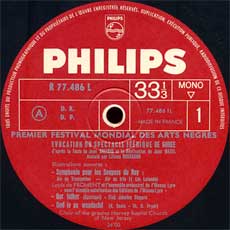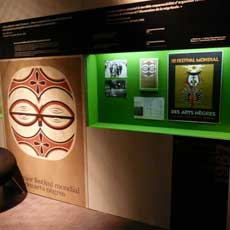01 Evocation du Spectacle Féérique de Gorée (24:06)
(Gorée Island Enchanting Tale)
Petite Musique de Cour des Rois Mandingue et Balante
(Ancient Court Music of the Mandingue and Balante Senegalese Kings)
02 Improvisation Pour Une Fête (kora and balafon) (2:55)
03 Air pour une Fiancée (balafon solo) (3:18)
04 Nocturne pour une Reine (kora improvisation) (2:03)
Songs of New Nations,
sung by the De Paur Chorus (New Jersey)
05 Ghana (2:54)
06 Nigeria (4:16)
07 Congo (2:11)
08 Nigeria (3:12)
09 Ghana (2:55)
Total time 47:40
LP released by Philips, France, 1966
 The idea of a World Festival of Negro Arts (1er Festival Mondial des Arts Nègres, aka FESMAN) was proposed at the Conference of Black Writers in Rome, 1956, organized by Alioune Diop (1910-1980), director of the ‘Présence Africaine’ journal in Paris, and publisher of African Literature and History books. A fellow Senegalese, poet Léopold Sédar Senghor (1906-2001) took part to this conference and, as soon as he was elected President of Senegal when the country proclaimed its independence in 1960, he offered Dakar, the capital, to host the festivities. Diop would be the Festival’s artistic director, with help from writer and négritude [+] champion Aimé Césaire and 2 assistants: Swiss anthropologist Jean Gabus (1908-1992) [+] and Cameroonian Jesuit priest and Art historian, Engelbert Mveng (1930-1995) [+]. But Senghor definitely wanted to use the event as a political lever and a négritude flagship, especially since North African countries rejected the concept in favor of Pan-Africanism [+], a doctrine aiming at a fierce independence towards Western countries.
The idea of a World Festival of Negro Arts (1er Festival Mondial des Arts Nègres, aka FESMAN) was proposed at the Conference of Black Writers in Rome, 1956, organized by Alioune Diop (1910-1980), director of the ‘Présence Africaine’ journal in Paris, and publisher of African Literature and History books. A fellow Senegalese, poet Léopold Sédar Senghor (1906-2001) took part to this conference and, as soon as he was elected President of Senegal when the country proclaimed its independence in 1960, he offered Dakar, the capital, to host the festivities. Diop would be the Festival’s artistic director, with help from writer and négritude [+] champion Aimé Césaire and 2 assistants: Swiss anthropologist Jean Gabus (1908-1992) [+] and Cameroonian Jesuit priest and Art historian, Engelbert Mveng (1930-1995) [+]. But Senghor definitely wanted to use the event as a political lever and a négritude flagship, especially since North African countries rejected the concept in favor of Pan-Africanism [+], a doctrine aiming at a fierce independence towards Western countries.
On April 1st, 1966, an international conference (with funding from UNESCO) opened the Festival which was to last until April 24th. A new art museum called Musée Dynamique (again with UNESCO funds) was build in Dakar to exhibit the numerous folk art and ceremonial objects sent by invited countries. For the first time in Africa, folk art was to be examined as Art, and cultural objects on display were compared to each other. The exhibition was shown in Paris as well, 6 months later. A theater was also build in Dakar, called Théatre Daniel-Sorano, to give the African premiere of La tragédie du Roi Christophe, a play by Aimé Césaire. Guest artists to the Festival included: historian Cheikh Anta Diop (1923 -1986); Arthur Mitchell and Alvin Ailey (of the American Negro Dance Company); Mestre Pastrinha, a Capoeira troupe from Bahia; Duke Ellington; Marion Williams; singers Julie Akofa Akoussah and Bella Bellow; writers Aimé Césaire, Langston Hughes, Wole Soyinka, Amiri Baraka and Nelson Mandela. In any respect, this Festival is a key event for Postcolonial studies.
This LP was presumably published by Philips in France in 1966, though the record itself has no proper release date. It looks like mere lip service from some French officials (namely, André Malraux) to Senghor, a loyal ally in Senegal, where the Total Group had been doing extensive oil business since 1954. It comes as no surprise the 2009 Paris exhibition (see below) is sponsored by Total. The first side of this LP, ‘Evocation du Spectacle Féérique de Gorée’, is a 24mn narration of the history of Senegal, Gorée Island and the slave trade, the birth of Dakar and independence of Senegal. It sounds like Ronald Reagan narrating the American Revolution – nation building produces more or less always the same sounds, regardless of continents –, complete with various songs, excellent percussion interjections, incidental music, environmental sounds and noises. Senegal’s national anthem, composed by Senghor, is a paean to kora and balafon, the national instruments. Their inclusion on the B side of this LP could only please Senghor.
Original impetus and basic information for this post come from the exhibition ‘Présence Africaine: A Forum, a Movement, a Network’ , held in Paris from Nov. 10, 2009 to Jan. 31, 2010 (see English press release PDF). Extensive use has been made of several articles from the catalog, especially by Eloi Ficquet and Lorraine Gallimardet. The LP itself is neither on display at the exhibition, nor mentionned in the catalog.











Love it – but I wish the guy would shut up on Evocation du Spectacle Féérique de Gorée.
AWESOME post! this is so cool.
Thank you both. This is a rather unusual disc, but, like you, I find it has a lot of charm.
Interesting. Tried to find this on the OCORA web sites but no luck. The historical points are on point but do not relate to the feeling of the time. FESMAN was a BIG deal! The narrative was played with actors on the Goree beach front, and the ending with the de Paur choir and canon shots was quite amazing. Haven’t listened to the download yet.
Thanks!
Jacques, the length of this post shows FESMAN 1966 is indeed a big deal to me. And when you eventually listen to the music, I’m confident you’ll agree something of the excitement and anticipation of people involved is obvious in the recording.
I’m not sure, though, there’s a link between this LP and the OCORA label, created by Pierre Schaeffer in 1955.
Thanks for your comment.
Another brilliant upload as usual, Continuo!
Heard this entire disc while stuck in the infernal traffic of Rio de Janeiro while rain poured in buckets – normally, in such situation, I curse and swear all I can. But on hearing such fine piece, I forgot all about the rain & traffic and just leaned back and relaxed hearing the songs.
Incidentally, there’s a very fine collection of Africana released by Harmonia Mundi on vinyl – I have two or three of them – one, especially, on the music of Madagascar, sticks to my mind till this day. Very good stuff – though, obviously, not as avant garde or experimental as this title.
cheers, s.
Oh, my! I thought it never rained in Brasil . . . Bloody climate change or what?
Seriously, I personally don’t consider this disc as Ethnic Music, but rather as a radio play on the A side, and nationalistic music based on folk tradition on the B side. If this is ‘avantgarde’, it’s a political one.
Thanks for your nice comment, Sergio.
Yes, obviously, this is no “ethnic music” – but a way of meshing western influences with local, folk pieces, with a highly interesting result. Very different from the Harmonia Mundi collection I mentioned, which is also brilliant, but very different from what is attempted on this release.
Continuo,
I cannot believe I’ve found this post – believe it or not, I am writing my dissertation (in ethnomusicology) on this festival. Where did you find your recordings? I had to travel to the Schomburg Center in NYC to access the LP and the video that you posted here.
Also, is there a way I can get in touch with Jacques? It seems he went to this festival, and I am trying to interview people who were there.
Thank you for mentioning the exhibit in Paris – I had no idea that was going on. I may try to get over there…
Your blog has truly been helpful, and it also encourages me that this is something of interest to people other than ethnomusicology nerds like me…
–Melissa
Hi Melissa,
I think this Festival encompasses many fields of interests, including politics, post-colonialism, African avantgarde (if there is such a thing), music made by Africans which is not ethnic music, etc. It seems a fantastic field of research for ethnomusicologists today. And ordinary laymen like myself might find the results exciting, too ;D
Hi there!
We are two students in history trying to find out about the FESMAN as well (presentation and a paper later!). End of next week we are holding a presentation and we are, as Melissa is, interested in the impressions and narrations of people who joined the festival as artists (or visitors). We want to hear from you about the meaning and the whole atmosphere in Dakar 1966!
And we’d like to get in touch with Melissa, if this is possible?!
Anna & Carsten
Hi Anna and Carsten,
Glad I’m not the only one interested in FESMAN! I’d be happy to talk to you by phone or email, as you wish. You can get my contact info from Mr. Continuo.
–Melissa
Hi all,
I’ve been doing research in Dakar for 15+ years (cultural policy/diplomacy, art exhibitions & cultural events). Obviously, the 1966 festival plays into this heavily!
I spent some time at the National Archives of Senegal in May. They have a guide to the archive’s holdings of material on the 1966 festival. It may be of interest if you haven’t already come across it.
If any of you plan on doing fieldwork there, the (detailed) guide would be helpful for any grant applications, so you can be specific about what you intend to do and show that you are aware of available materials/accessibility. This would certainly strengthen your application.
It might be available at libraries–the Smithsonian’s National Museum African Art Library has unparalleled holdings, and likely carries it. It may also be available via interlibrary loan from some institutions. If you don’t find it that way, you may be able to get in touch with the Archives to see if they are willing to send a copy so you could get a sense of what material they have (i think it was 3000 CFA).
Kinsey
Kinsey,
I wonder if I saw you at the archives – I was there in May, too! I was going pretty much every day from the last week of April to the 2nd week of May. I’m writing my dissertation on the Festival (its music, specifically). I’ll be going back in October for 9 months – perhaps you’ll be there, too? Are you planning on going to FESMAN III this December?
–Melissa
Could someone English speaking get in touch with me right away!
1-586-563-6639
I got a MINT copy, never been played…
I am very excited about what i can find about FESMAN, especially the first and second one. I have participated in the third one. I would to get in touch with Melissa. I am a doctoral student and i ma doing research on the negritude movement and FESMAN while looking at the participation of women.